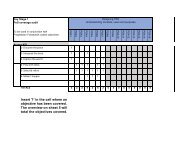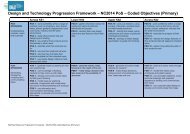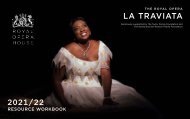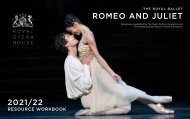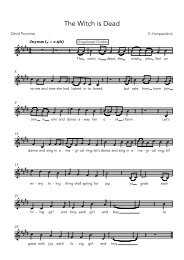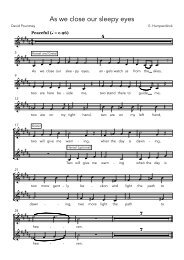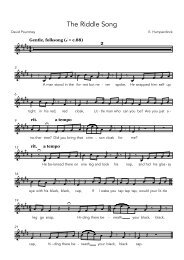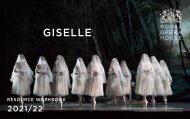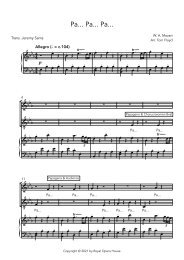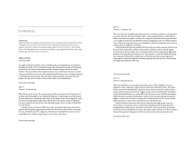Infra GCSE Resource
Create successful ePaper yourself
Turn your PDF publications into a flip-book with our unique Google optimized e-Paper software.
CREATIVE EXPLORATION TASKS<br />
76<br />
INFRA SECTION 7 EXPLORATION<br />
Watch the duet danced by Lauren Cuthbertson and Mara Galeazzi<br />
(phrase 3a, 21:32–21:54 on the film) from section 7. This duet communicates<br />
the sharing of grief, the dancers’ movement is fluid and they demonstrate<br />
physical empathy by echoing and complementing/enhancing the other<br />
dancer’s movements, sometimes dancing in unison and sometimes overlapping,<br />
like a conversation. Gradually the distance between them increases and they<br />
go their separate ways.<br />
Work in groups of three. Two people<br />
are the ‘Dancers’ and one person is the<br />
‘Choreographer’. The choreographer will<br />
use the dancers’ ‘physical signature’ solos<br />
from the ‘Section 1 exploration’ tasks to<br />
create a duet between the dancers that<br />
shows empathy 8 in a physical way.<br />
CREATIVE EXPLORATION TASKS: INFRA SECTION 1<br />
TASK 1: CONFIGURING DANCERS<br />
TASK 2: PHYSICAL SIGNATURE SOLO<br />
TASK 3: PERFORMANCE SCALE 1, 2, 3<br />
CREATIVE EXPLORATION TASKS: INFRA SECTION 5<br />
TASK 1: SELECTING VOCABULARY<br />
TASK 2: TOOLS FOR DEVELOPING VOCABULARY<br />
TASK 3: CREATING A PARAGRAPH OF MOVEMENT<br />
CREATIVE EXPLORATION TASKS: INFRA SECTION 7<br />
TASK 1: EMPATHY DUET<br />
TASK 2: PROSAIC PEDESTRIAN SOLO<br />
TASK 3: CREATING A TRIO<br />
VISUAL IMAGERY TASK<br />
POETRY AND MUSIC TASK<br />
30 minutes<br />
2 dancers +<br />
1 choreographer<br />
8. Empathy – The ability to<br />
understand and share the feelings<br />
of another. In <strong>Infra</strong>, physical<br />
empathy is explored, where one<br />
dancer shares another dancer’s<br />
movement or movement quality.<br />
See Appendix A for full glossary.<br />
a Recap individual ‘physical signature’ solos (or any other individual<br />
solo if students have not completed the Section 1 exploration)<br />
b Dancers perform their solos next to each other in close proximity,<br />
with choreographer watching the performance a minimum of<br />
three times.<br />
c Choreographer observes and makes a note of any moments of<br />
the solos that are highlighted by the others movements. E.g.:<br />
+ + Movements in the same direction<br />
+ + Movements in different directions<br />
+ + Actions that have the same speed or rhythmic quality<br />
+ + Points where each of the dancers’ movements crosses/uses the same<br />
space<br />
+ + Different actions with the same body parts<br />
+ + Opportunities for contact between dancers?<br />
d The choreographer experiments with the dancers’ movement using<br />
the following tools:<br />
+ + Action and reaction – one person moves and the other reacts to their<br />
movement, using their own movement vocabulary.<br />
+ + Repetition and development – one person moves and the other interprets<br />
their movement (Wayne McGregor calls this ‘hijacking movement’)<br />
before developing it further, taking it in turns to develop the other dancer’s<br />
previous movement.<br />
+ + Moments of unison – both dancers perform their solos, overlapping<br />
their movement, and then periodically joining together in unison before<br />
continuing their own dance.<br />
+ + Echoing/complementing movement – one dancer performs their solo<br />
and the other echoes the dynamic quality, rhythm or spatial pattern of<br />
their movement using their own solo movement, using notes from initial<br />
observation.<br />
+ + Adding moments of contact or complete stillness.<br />
e Together the choreographer and dancers create a duet that<br />
demonstrates the idea of a conversation and physical empathy.





